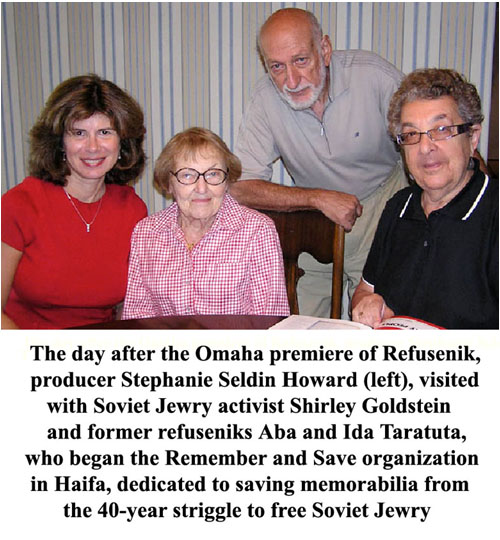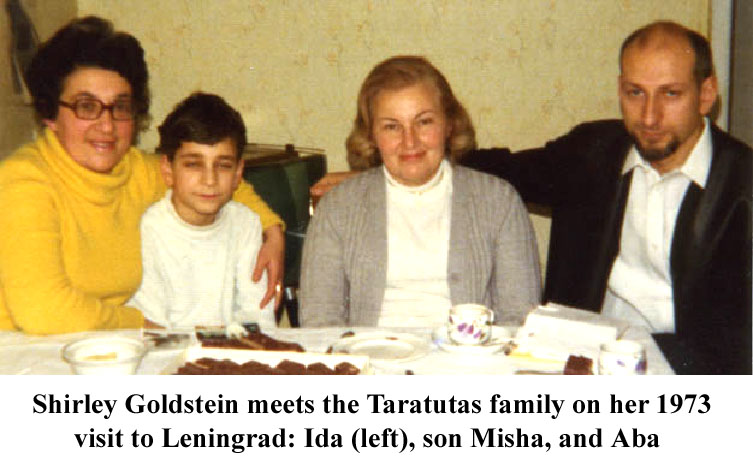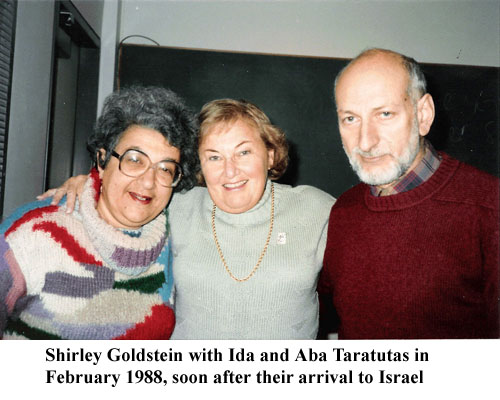Refusenik:
How it all began
By Carol Katzman,
Editor of the Omaha Jewish Press,
October 3, 2008
Sitting in front of the giant movie screen at Film Streams after the Omaha showing of Refusenik, a diminutive Shirley Goldstein listens to producer Stephanie Seldin Howard recall the documentary's beginning.
Friends with Laura Bialis, director of another documentary, Tak for Alt, about Holocaust survivor Judy Meisel, Howard turned to Bialis and said, "I've got an idea for your next film -- a documentary about a 'housewife' in Omaha."

The struggle to free Soviet Jews had "captured my imagination," Howard said, recalling her USY days in Omaha and the protest marches originating from Beth El.
True to her modest nature, however, Goldstein told Howard she would only "do the film" if Howard and Bialis interview the many other activists and refuseniks who helped bring down the Soviet regime.
And so began the three-year project which culminated in the documentary Refusenik, a history celebrating the 40-year struggle to free Soviet Jewry. Hundreds of interviews later, countless solicitations for funds, and hour upon hour searching archives for photos, film footage and documents, Howard proudly points to the results: a chronicle with major players of the exodus of more than 1.5 million Jews from the former Soviet Union.
Among those who were finally allowed to leave (one of the last) were Aba and Ida Taratuta, the "go to" couple all activists visited when they arrived in Leningrad (now known again as St. Petersberg). Not only were they the first refuseniks Goldstein met, they were present at the Omaha premiere.
Goldstein had been taking a class at Omaha University (now the University of Nebraska-Omaha). Inspired by the class and her desire to learn more about the country of her parents and grandparents, Goldstein signed on to a university-led trip with her daughter, Gail Raznick of Boulder, CO, and Miriam Simon and her daughter, Julie. It was Shirley's second trip to the USSR; the first, with her husband Leonard, "was a disappointment," she said, as the Intourist guides wouldn't give her any information about the history of the Jews or their current status.
This trip, in 1973, however, was different. "Every Sunday morning, when Buddy was out playing golf," she told the Press, "I called Glenn Richter, my cousin Lenore's husband, in New York." Richter, head of the fledgling Student Struggle for Soviet Jewry, gave Goldstein a private tutorial, adding a chapter each week of names, locations, history of "refusal" and more.
He not only told her what to bring (jeans, cameras and other goods that could be sold on the black market so refuseniks could support themselves and their families), he warned her about the KGB, the Soviet spy organization that watched refuseniks -- and their visitors.

"I was given the Taratuta's phone number and address," Shirley noted, "but I didn't tell my daughter anything until we were ready to leave. I gave her the chance to back out." Gail laughed and said, "Why would I miss an adventure like that? Besides, I was afraid for Mom to go out after dark by herself."
According to a May, 2006 article in the Jewish Press, Taratuta told author Leo Adam Biga, "She was interested in our life, financial situation, the possibility to leave the country and what to do and how to help," he said. "She was ready to do everything to help us. And from that visit there was just a constant contact between our families. She wrote a lot of letters describing what she did to help us and other refuseniks. She became very active in the struggle on our behalf."
He added, "Shirley brought many items--books, records, tape recorders--that helped us in studying Hebrew or in supporting Zionist activities. The same with cameras, watches and jeans, which we sold. And every time she would bring something personally for us, for our family."
Stephanie Howard said Ida Taratuta recounted how once Shirley "came with a suitcase full of embroidered towels, fine soaps and things, and Ida told her, 'I can't accept this,' to which Shirley said, 'But for a twist of fate, I could have been in your place and you could have been in mine. Wouldn't you do the same for me?' And Ida replied, 'How can I argue with that? Of course.'"
Shirley called the Taratutas the first day they arrived in Leningrad and were told to come that night. "But when we arrived, we noticed lots of cars and men watching the building, so we left. "They returned the next night after Aba assured Shirley that the "watchers" were there all the time. "We had only been in 'refusal' for five months," Ida Taratuta recalled, "we were too young and inexperienced to be afraid."
Arriving at the small two-room flat, Shirley instructed her daughter to "give the Taratutas the Jewish books." Digging into her wide leg boots, Gail withdrew a number of small books that Shirley had literally smuggled into the USSR. The two women were the first Americans to visit the Taratutas; many, many others would follow.
In order to get an exit visa, a refusenik had to have an invitation from someone in America or Israel. But it was a Catch-22; without getting the names and vital statistics of a refusenik to the outside, the refusenik could not get the invitation. "We wrote up a list and gave it to a friend who was actually getting out in 1973," Aba recalled. "Ida opened up the back of his jacket and sewed the list into the lining."
Then they waited. They became refuseniks in April 1973 and started the process. By August they had received an invitation. And then they watched as one refusenik after another was tried and sentenced to prison. While they waited, Aba Taratuta was reduced to becoming "a lift operator," a job held by more Ph.D.s in the USSR than most major universities in the 1970s and '80s. Later Ida would teach English, using a picture method developed by an educator in California.
"Shirley visited us in Leningrad several times and she was interested in seeing more people, more refuseniks. And for a foreigner in Russia it was not so easy to do," Aba Taratuta said in the May 2006 article in the Press. "So we tried to gather as many people in our apartment as possible. She was interested in every one and taped the story of everyone and smuggled the tapes out on her person. And it was really dangerous.
"In turn, Goldstein said Aba "was one of the main figures in Leningrad. Gail and I were the first Americans to ever visit him, but he was already well known in the West." She said he'd "have so many activists come to his apartment ... they crowded to get into the rooms. I kept coming back to hear their stories. I made tapes."
She smuggled out the tapes in her bra, she said, because they always searched suitcases and purses.
The Taratutas were classic refuseniks-turned-activists. Their situation symbolized the problem, Goldstein told Biga.
"They'd applied to emigrate and were released from their jobs. They were well-educated people. Both spoke good English. He had been a professor. She was a translator. I think maybe they were receiving some packages from the West and selling things on the black market. Mail and phone service was compromised. That's the way it was."
And throughout the 15 years of their "refusal", the Taratutas welcomed activists from America, the United Kingdom, France and elsewhere into their home, each one offered tea and information to disseminate to the Western media, and government officials.
Fortunately for the Taratutas, the KGB never banished them to the Gulag, as they did their famed colleague Natan Sharasnky, but they were one of the last couples allowed to leave, in 1988.

Today, the couple lives in Haifa, where Aba is the executive director of the Save and Remember Association. Not only does he have the daunting job of organizing the massive archives left to his group by Shirley Goldstein and other activists, he was instrumental in launching last spring's exhibit at the Diaspora Museum in Tel Aviv of the 40-year struggle.
The documentary, however, is only the tip of the iceberg. The phrase, "left on the cutting room floor", certainly applies here, as the documentary originally spanned nine hours. But, responded Howard to a question at the film's premiere here last month about curriculum, there is hope that the transcripts of interviews and archives of photos and film footage might someday become a book.
"Someday," she added, noting that it would need additional funding -- and someone to actually write the curicullum, much like Yad Vashem and the Anti-Defamation League teamed up to write, Echoes and Reflection, a curriculum for teaching the Holocaust.
Though Taratuta does point to the catalog of the Diaspora Museum exhibit with pride, he agrees with Stephanie Howard that the next step should probably be a book and a curriculum. In the meantime, he continues to unpack and sort through boxes.
The organization is also seeking financial assistance to support its work. U.S. tax deductible contributions of at least $25 may be sent (and must be made payable) to: P.E.F. Israel Endowment Funds, Inc., 317 Madison Ave., Suite 607, New York, NY 10017, with a recommendation it be used for the archive's preservation purposes. For more information, check out the 'Remember and Save' website at www.soviet-jews-exodus.com.
Richter told Biga for the May 2006 series on Goldstein that she and Buddy were well-positioned to serve the cause.
"One of the great strengths of Jews in smaller Jewish communities, such as Omaha or Denver, is the long-term friendships they may have with people who get into political power," Richter said.
"Shirley and Buddy were excellent examples. Their Congressmen and Senators became their advocates. Shirley knew which political buttons to press, and did so on behalf of individual refuseniks and prisoners and of the Jackson-Vanik Amendment--the landmark legislation linking Jewish emigration with trade credits for the USSR."
|